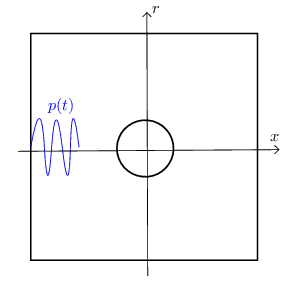Wave scattering by an elastic sphere submerged in an incompressible fluid is described by the equation
| (1) |
where:
-
is the displacement [m]
-
is the density [kg/m]
-
are the bulk, shear elastic moduli [N/m].
Elastic media sustain two types of waves:
-
longitudinal or -waves (pressure waves) with wave velocity
-
transverse or -waves (shear waves) with wave velocity
Consider a plane pressure wave , entering a cube of side m filled with water ( kg/m, m/s, ) containing a steel sphere of radius m ( kg/m, m/s, m/s) (Fig. 1)
 |
-
Derive time evolution equations for the curl , and divergence , first in vector form, and then in spherical coordinates assuming axisymmetry. What is the type of these equations? How many independent curl components arise in the axisymmetric case? (1pt)
-
Consider the Helmoholtz decomposition . Determine the time evolution equations for , again in vector and axisymmetric coordinate forms. As above, what is the type of the equations? How many independent components of the vector potential arise in the axisymmetric case? (1pt)
-
Solve for by:
-
leap-frog
-
Lax-Friedrichs
-
upwind
-
Lax-Wendroff
Model the sphere by modification of the material properties (). Carry out the time integration to allow both waves reflected by the sphere and those refracted by the sphere to leave the domain. Present convergence behavior for all schemes. (4 pts)
-
-
Solve for by the same methods as above. Reconstruct , compute and compare with solutions obtained from above at each considered grid resolution. (6 pts)